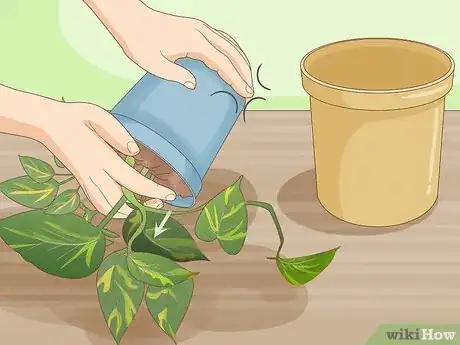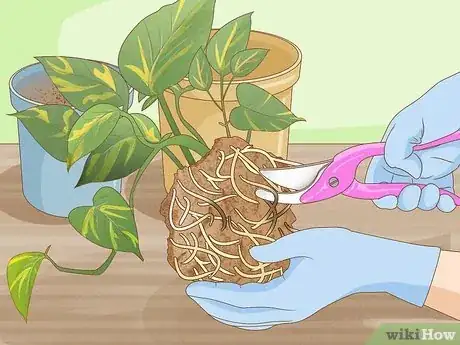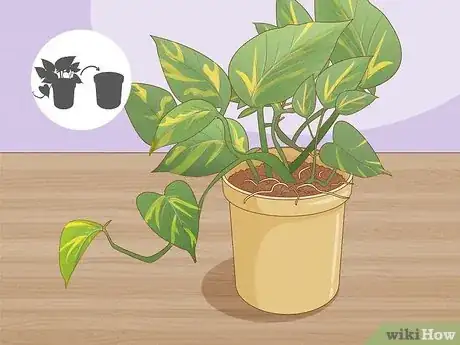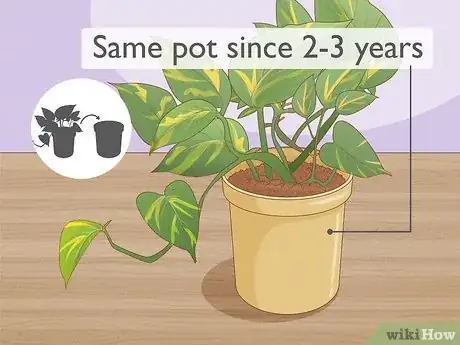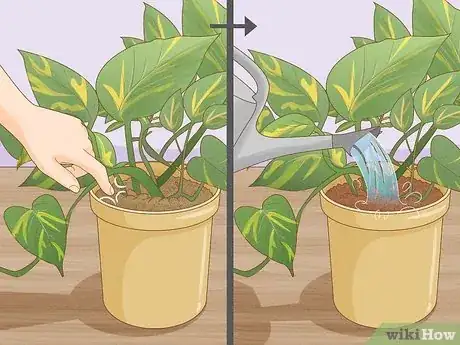This article was co-authored by Lindsey Swett and by wikiHow staff writer, Luke Smith, MFA. Lindsey Swett is a Plant Specialist and the Owner of Niche Plant Shop in Boston, Massachusetts. She has over a decade of experience working in several plant settings, including golf courses, public parks, and commercial garden centers. Her focus now is on helping plant owners care for their indoor plants. Lindsey holds a Master of Landscape Architecture from The University of Michigan.
There are 11 references cited in this article, which can be found at the bottom of the page.
Pothos have fast-growing tendrils that add a wonderful bit of green to any room. But because those tendrils grow so quickly, it means your pothos might outgrow its current pot and be in need of repotting. Don’t worry! Repotting your pothos is simple and easy, and we’re here to let you know when and how to do it, as well as how to care for your pothos afterward.
Things You Should Know
- Your new pothos pot should be about 2 inches larger than the current pot.
- Before repotting, loosen and trim away damaged roots.
- You should repot your pothos when the roots start overgrowing, the leaves are wilting, or otherwise every 2-3 years.
- Keep your pothos healthy with adequate water, indirect sunlight, and appropriate soil mix.
Steps
Repotting a Pothos
-
1Prepare a new pot that’s about 2 inches larger than the current pot. Fill the new pot about halfway with fresh potting mix, so that the pothos has new, nutrient-rich soil in which to grow. Make sure to leave enough room for the pothos itself!
- It’s important not to go too big, too quick. A bigger pot means more soil, and more soil takes longer to dry between waterings. This could rot the roots of your pothos.[1]
- Many houseplant owners prefer clay pots for their indoor plants. Clay pots allow water to pass through their walls and evaporate into the air, which helps avoid overwatering.[2]
-
2Remove the pothos from the old pot. Carefully grab the base of the pothos, without pulling on the plant. Then gently tip the pot on its side while tapping the bottom in order to loosen the soil and any crowded roots. Continue to do this until the pothos slides out of the pot. [3]
- If the pothos doesn’t come loose, separate the soil from the edges of the pot with a trowel or butterknife.[4]
- It's best to repot your plant when it's neither too dry nor too wet. You might repot it at the halfway point of your watering cycle.
Advertisement -
3Use your fingers to loosen the roots. Your plant will grow better if the roots spread out in the new pot. Since the roots are likely root bound, break them up before placing the plant in its new pot. To do this, gently massage the roots with your fingers to break up the dirt and free the roots.
- Try not to pull on the roots too hard because you might accidentally break them.
-
4Cut away any dead or damaged roots. Brush away any loose dirt from the roots of the pothos so that you can get a good look at them to see if they're healthy or rotten. If the roots are densely packed or are spiraling around the base of the plant, this means your pothos has become “pot-bound.” In this case, gently break up the roots and trim away the outside, circling roots.[5]
-
5Place the pothos in its new pot and add soil. Carefully place the pothos in the center of its new pot, on top of the layer of soil you’ve already added. Then, add more new soil until the soil is level with the old soil of the root ball.[6]
- Don’t fill your pot completely with soil. Instead, leave about an inch between the top of the soil and the lip of the pot, so there’s plenty of room to water without making a mess.[7]
-
6Water the pothos until the soil is moist. Keep watering until you see drips coming from the bottom of the pot. This means the soil is totally saturated, and your pothos is happy and comfortable in its new home!
Things You’ll Need
- A new pot, about 2-3 inches larger than the old pot
- Fresh planting soil
- Garden trowel (optional)
References
- ↑ https://hort.extension.wisc.edu/articles/houseplant-care/
- ↑ https://www.missouribotanicalgarden.org/gardens-gardening/your-garden/help-for-the-home-gardener/advice-tips-resources/gardening-help-faqs/question/504/what-are-the-best-containers-for-indoor-plants.aspx
- ↑ https://wayne.ces.ncsu.edu/2022/04/repotting-houseplants/
- ↑ https://getplanta.com/article/repotting/pothos
- ↑ https://extension.illinois.edu/blogs/good-growing/2018-03-19-tips-repotting-houseplants
- ↑ https://wayne.ces.ncsu.edu/2022/04/repotting-houseplants/
- ↑ https://extension.psu.edu/repotting-houseplants
- ↑ https://hort.extension.wisc.edu/articles/houseplant-care/
- ↑ https://hgic.clemson.edu/factsheet/houseplant-diseases-disorders/
- ↑ https://gardenine.com/root-bound-pothos/
- ↑ https://extension.uga.edu/publications/detail.html?number=B1318&title=Growing%20Indoor%20Plants%20with%20Success#water
- ↑ https://simplifyplants.com/pothos-plant-water-requirement/
- ↑ https://extension.uga.edu/publications/detail.html?number=B1318&title=Growing%20Indoor%20Plants%20with%20Success#water
- ↑ https://simplifyplants.com/pothos-lighting-requirements/
- ↑ https://extension.uga.edu/publications/detail.html?number=B1318&title=Growing%20Indoor%20Plants%20with%20Success#water
- ↑ https://extension.uga.edu/publications/detail.html?number=B1318&title=Growing%20Indoor%20Plants%20with%20Success#water

